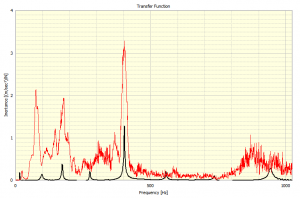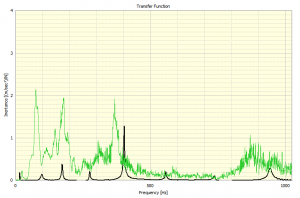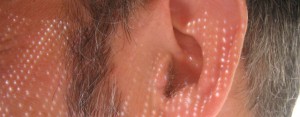In the previous two articles (What Is Resonance? (Part 1) & What Is Resonance (Part 2)) in this series we have looked at how we can identify a resonant frequency. Now we will discuss what happens next. What do we do when the resonant frequency of a structure has been found? We will also look at some potential ways of dealing with a resonance is in a structure, body or piece of equipment.
First, it is necessary to understand what a resonance is. A resonance occurs when the natural frequency of a structure is excited by an input. If the frequency of the input matches the natural frequency of the structure, that is the excitation frequency matches the natural frequency, then a resonance occurs.
Generally, performing a test like a hammer impact test on a structure or capturing a run-up or run-down will enable the natural frequency to be observed.
A natural frequency is the frequency of free vibration of a structure at which the structure vibrates to dissipate energy. The natural frequency () of a structure, expressed in radians per second, is a function of its stiffness (
) and its mass (
), as shown by the following equation:
If either the () or (
) parameters are altered, then the natural frequency will change.
If you want to modify the natural frequency of a structure, then you need to change either the stiffness () or the mass (
). Increasing the mass or lowering the stiffness will lower the natural frequency while reducing mass or increasing stiffness will increase natural frequency.
In summary
- Increasing mass or decreasing stiffness will reduce the natural frequency
- Decreasing mass or increasing stiffness will increase the natural frequency
Sometimes it is not possible to change the mass or stiffness of a structure. So how can we solve a resonance problem?
Several options are possible, but there are two common and relatively simple solutions.
The first option would be to change the operating speed of the equipment. This will move the operational range away from the natural frequency. In basic terms, you are changing the excitation frequency and moving it away from the natural frequency. Depending on the natural frequency and the frequencies of operation of the equipment this may require only a small change in speed. In other cases it might require such a large change in speed that it is not possible for operational reasons.

For example, Figure 1 shows the response of the equipment (red curve) at a certain speed. The black curve shows the natural response of the structure when the equipment is at rest. It is clear that we are exciting the natural frequency of the equipment at around 400Hz.

By changing the running speed of the equipment we can change the frequency of the excitation. So by avoiding the natural frequency we reduce magnitude of the vibration. In figure 2 we see that by reducing the excitation frequency from 400Hz to around 365Hz we have significantly reduced the overall vibration.

The second solution is to install a dynamic absorber (as shown in Figure 3) . This significantly reduces the vibration levels. The dynamic absorber is usually a spring-mass system that is installed in series with the resonant system to create an out-of-phase exciting force to effectively counteract the initial excitation force.
Further Reading
What Is Resonance? (Part 1) (https://blog.prosig.com/2007/05/23/what-is-resonance/)
What Is Resonance? (Part 2) (https://blog.prosig.com/2012/08/20/what-is-resonance-part-2/)
5 Videos That Explain Resonance (https://blog.prosig.com/2011/09/20/5-videos-that-explain-resonance/)
A Simple Frequency Response Function (https://blog.prosig.com/2009/10/19/a-simple-frequency-response-function/)
James Wren
Latest posts by James Wren (see all)
- What Are dB, Noise Floor & Dynamic Range? - January 12, 2024
- How Do I Upsample and Downsample My Data? - January 27, 2017
- What Are Vibration, Torsional Vibration & Shaft Twist? - November 8, 2016





James, can you please e-mail me copies of Parts 1 & 2? Also, can you please point out the “absorber” in Fig. 3?
Do you have any information on treating natural frequency related radial vibration problems in high speed rotating equipment?
Hi Linda,
I can’t email you copies of the first two articles, I can however give you the links directly,
https://blog.prosig.com/2007/05/23/what-is-resonance/
https://blog.prosig.com/2012/08/20/what-is-resonance-part-2/
But rather than use those links, I would suggest that you search for resonance in the search box on the Prosig blog, this way you’ll find many useful articles and videos that may help explain further.
The dynamic absorber is the large brown metallic part you can see in the picture.
We at Prosig have many years experience with rotating equipment and of course the associated vibration problems. We don’t any information we can provide you with, but please feel free to contact us directly with any specific questions you may have, we’ll try to assist if possible.
Good article James!
Thanks Guilherme, it is good to know these articles are appreciated, thank you for taking the time to let us know.
A continuous structure has infinite number of natural frequencies.Why is it that the first NF is the most important one to avoid?
Hi Ahmad,
Your correct, a continuous structure does indeed have an infinite number of natural frequencies.
The first is only really the most important because it is usually has the largest amplitude.
Generally the higher the number of the natural frequency then the less important it is, but clearly this does not apply in all cases as sometimes some of the higher natural frequencies can have larger amplitudes than lower and so on.
Pingback: How Do I Measure Resonance?